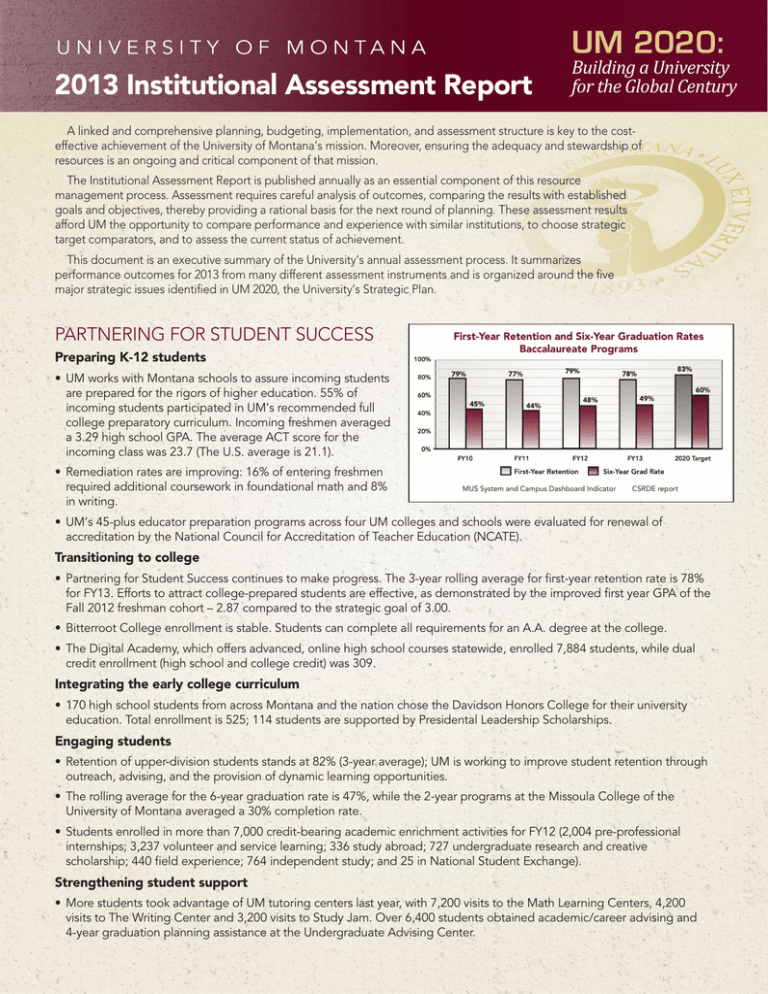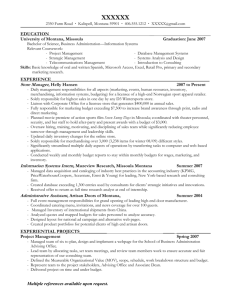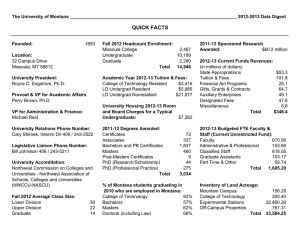UM 2020: 2013 Institutional Assessment Report Building a University for the Global Century
advertisement

UM 2020: 2013 Institutional Assessment Report Building a University for the Global Century A linked and comprehensive planning, budgeting, implementation, and assessment structure is key to the costeffective achievement of the University of Montana’s mission. Moreover, ensuring the adequacy and stewardship of resources is an ongoing and critical component of that mission. The Institutional Assessment Report is published annually as an essential component of this resource management process. Assessment requires careful analysis of outcomes, comparing the results with established goals and objectives, thereby providing a rational basis for the next round of planning. These assessment results afford UM the opportunity to compare performance and experience with similar institutions, to choose strategic target comparators, and to assess the current status of achievement. This document is an executive summary of the University’s annual assessment process. It summarizes performance outcomes for 2013 from many different assessment instruments and is organized around the five major strategic issues identified in UM 2020, the University’s Strategic Plan. PARTNERING FOR STUDENT SUCCESS Preparing K-12 students • UM works with Montana schools to assure incoming students are prepared for the rigors of higher education. 55% of incoming students participated in UM’s recommended full college preparatory curriculum. Incoming freshmen averaged a 3.29 high school GPA. The average ACT score for the incoming class was 23.7 (The U.S. average is 21.1). • Remediation rates are improving: 16% of entering freshmen required additional coursework in foundational math and 8% in writing. MUS System and Campus Dashboard Indicator CSRDE report • UM’s 45-plus educator preparation programs across four UM colleges and schools were evaluated for renewal of accreditation by the National Council for Accreditation of Teacher Education (NCATE). Transitioning to college • Partnering for Student Success continues to make progress. The 3-year rolling average for first-year retention rate is 78% for FY13. Efforts to attract college-prepared students are effective, as demonstrated by the improved first year GPA of the Fall 2012 freshman cohort – 2.87 compared to the strategic goal of 3.00. • Bitterroot College enrollment is stable. Students can complete all requirements for an A.A. degree at the college. • The Digital Academy, which offers advanced, online high school courses statewide, enrolled 7,884 students, while dual credit enrollment (high school and college credit) was 309. Integrating the early college curriculum • 170 high school students from across Montana and the nation chose the Davidson Honors College for their university education. Total enrollment is 525; 114 students are supported by Presidental Leadership Scholarships. Engaging students • Retention of upper-division students stands at 82% (3-year average); UM is working to improve student retention through outreach, advising, and the provision of dynamic learning opportunities. • The rolling average for the 6-year graduation rate is 47%, while the 2-year programs at the Missoula College of the University of Montana averaged a 30% completion rate. • Students enrolled in more than 7,000 credit-bearing academic enrichment activities for FY12 (2,004 pre-professional internships; 3,237 volunteer and service learning; 336 study abroad; 727 undergraduate research and creative scholarship; 440 field experience; 764 independent study; and 25 in National Student Exchange). Strengthening student support • More students took advantage of UM tutoring centers last year, with 7,200 visits to the Math Learning Centers, 4,200 visits to The Writing Center and 3,200 visits to Study Jam. Over 6,400 students obtained academic/career advising and 4-year graduation planning assistance at the Undergraduate Advising Center. • 80% of students participating in the pre-medical advising program were admitted to medical school. UM pre-med students were accepted to Northwestern, Vanderbilt, the University of Colorado, and Washington University. • Less need-based financial aid is available to Montana students than in other states. Western Interstate Commission for Higher Education (WICHE) data show Montana providing $108 per undergraduate FTE, compared to the WICHE average of $582 and the US average of $527. Emphasizing faculty and staff development • The Faculty Development Office held 25 professional development sessions, attended by 386 faculty members. • 38 faculty members were awarded Sabbatical leaves in 2012-13 and 7 international faculty exchanges were organized. • More than 40 staff members were appointed to the working groups tasked with making recommendations addressing University budget matters. EDUCATION FOR THE GLOBAL CENTURY Strength in foundational academic programs • Counselor Education and Athletic Training were re-accredited by the Council for Accreditation of Counseling and Related Educational programs (CACREP) and the Commission on Accreditation of Athletic Training Education (CAATE). • The National Council for Accreditation of Teacher Education (NCATE) made a site visit as part of the renewal process for more than 45 educator preparation programs across four UM colleges and schools. The final accreditation decision will be rendered in October 2013; the preliminary NCATE report indicates all standards were met. • The Accreditation Council for Pharmacy Education (ACPE) granted the Skaggs School of Pharmacy’s Doctor of Pharmacy program at UM re-accreditation for a period of eight years, the maximum term allowed. • The Accrediting Council on Education in Journalism and Mass Communications (ACEJMC) reaccredited the undergraduate program in Journalism for a period of six years. Two-year programming responsive to local, regional, state and national needs • Missoula College continues to offer outstanding instruction.The 2012 National NCLEX PN and RN Licensure Exam pass rates for nursing students were 100% on each exam. • Two new certificates, Energy Technology and Health Information Technology, were approved at Missoula College. Global engagement and leadership at all levels • The Global Leadership Initiative enrolled an additional 225 freshmen. The GLI encourages students to contemplate their overall education and focus on significant interdisciplinary questions and challenges faced by people in our global society. • UM ranks 12th among medium-sized universities in Peace Corps undergraduate alumni volunteers. • Two students (Patrick Funk & Erin Hastey) were selected to intern in Germany, through the German Academic Exchange Service (DAAD) RISE professional program. Innovation through graduate education • The number of graduate degrees awarded remains high, with 788 students earning master, professional, and doctoral credentials. • Curtis Wallette, a student in the MBA program, won 1st place out of over 1,750 entrants in the 2013 Capsim Challenge, where competitors simulate management of a multimillion dollar corporation. DISCOVERY AND CREATIVITY TO SERVE MONTANA AND THE WORLD Enhance contributions by faculty and students through research • Faculty and student research led to 13 patent applications, 12 invention disclosures, 4 license agreements and 3 new companies. • The Thomson Reuters World University Rankings for 2012-2013 placed UM in the top 300 universities world-wide. The composite measure of research impact (citations) was 72.1, a figure comparable to that of several universities ranked in the top 50. Expand knowledge and cultural diversity through creative scholarship • UM faculty and students were responsible for 373 visual and performing arts exhibitions and performances in 2013. • Publication of scholarly articles acknowledged in ISI citation indices (natural and social science journals) reached 533. • UM won 1st place in the National Opera Association Collegiate Scenes Competition for undergraduate presentations. • UM swept the district Metropolitan Opera Council auditions voice competition. 1st places went to Neila Getz, John Knispel, and Arielle Nachtigal. Turn today’s discoveries into tomorrow’s products through technology transfer, contributing to the creation of ideas, jobs, and business opportunities. • The volume of extramurally funded research activity was $61.5 million in 2012. DYNAMIC LEARNING ENVIRONMENT People – Lead in recruiting, retaining, and developing the highest quality students, faculty, and staff UM students receive an extraordinary number of national awards for their scholarly activities. • Ten UM students received Fulbright awards. • Mara Menahan was the recipient of a Udall Fellowship, UM’s 36th Udall award. • Kim Ledger received a Goldwater Scholarship, UM’s 10th Goldwater award. • Rebecca Boslough won a national Truman Scholarship. She is UM’s 13th Truman Scholar. • Dakota Whistler and Justin Davis received 2nd place and honorable mention for their Level 2 Russian essays in the annual competition coordinated by the American Council of Teachers of Russian. Faculty are recognized for their contributions in research, teaching, and service. • The American Association for the Advancement of Science appointed Professor Charles Thompson as a 2013 AAAS Fellow. The prestigious fellowship recognizes an individual’s contributions to science and technology. Programs – Provide programs of distinction, create local and world-wide partnerships, connect programs to our unique locations • Creative Writing, Wildlife Biology, and Organismal Biology & Ecology were recognized as Programs of National Distinction. • UM added a Digital Marketing Certificate, an Option in Genetics and Evolution, a Certificate in Health Information Technology, and a Certificate of Applied Science in Energy Technology. In May, the Board of Regents approved a new Ph.D. program in Materials Science (in collaboration with Montana Tech and Montana State University). • Online student credit hours remain high at 25,080. Infrastructure – Use technologies and practices that optimize the learning experience while modeling sustainability • The Interdisciplinary Science Building has entered the final development stage on three floors. This will provide four new research laboratories and an extensive suite of support core facilities. • The Montana Legislature approved $29 million for construction of a new facility for Missoula College and spending authority for another $3 million for the construction to be raised by UM. • The Montana Legislature also approved spending authority for privately funded construction projects: Gilkey Executive Education Center, the Mansfield Library’s Learning Commons, and the Student-Athlete Academic Center. Culture – Encourage engagement and a passion for learning in all students • UM students can attend and participate in hundreds of lectures, conferences, performances, and exhibits. They can join any of more than 192 student groups supported by the Associated Students of the University of Montana. Place – Integrate the character of the campus environment into discovery and instruction • Founded in 2007, UM’s Crown of the Continent Initiative has been expanded to include both Glacier National Park and the Greater Yellowstone region and ecosystem. PLANNING-ASSESSMENT CONTINUUM Linkage of plans and resources • The UM Strategic Plan, published in spring 2011, was developed through a collaborative effort that included input from diverse constituents across campus. Closely linked with the new NWCCU accreditation process, it sets the strategic directions that will shape the University for the remainder of the decade.The plan, updated annually, includes performance indicators by which progress toward mission achievement will be measured. • The combined endowment value for UM and the University of Montana Foundation was $136,053,838. • The University has committed 67.3% of FY13 general funds toward instruction, academic support, and student services – down from 68.5% in FY12. The 2020 strategic goal is 70%. Transparent and participative processes throughout the cycle • The VP for Administration and Finance held weekly, open meetings of the University Budget Committee to discuss the UM budget in spring 2013. Five working groups (Enrollment Management; Revenue Enhancement; Resource Allocation; Cost Savings; and Academic Programming) were created to collectively address University budget matters. • 100% of UM’s strategic and operating plans are published and available online. Annual assessment reports and budget allocations are also published and available to the campus and the community. Data-driven decisions and goal-setting • Structured parallel to the Strategic Plan, this Institutional Assessment Report, along with the more detailed assessment data upon which it is based, forms the basis of the President’s annual State of the University message at the beginning of the new academic year. • On schedule, the University Planning Committee will update the Strategic Plan in fall 2013 to reflect current assessment data, and will refine the planning priorities for the upcoming biennium. Objective and timely assessment of outcomes • The Writing Committee assessed a representative sample of student papers from lower-division writing courses: 4% of the papers were scored as novice, 27% nearly proficient, 55% proficient, and 13% advanced, indicating that lower-division writing courses are preparing students in critical writing skills. • The institutional assessment reports, including the UM Report Card, are published at the conclusion of each fiscal year. 7-1-13 Printed on recycled paper with eco-friendly inks



